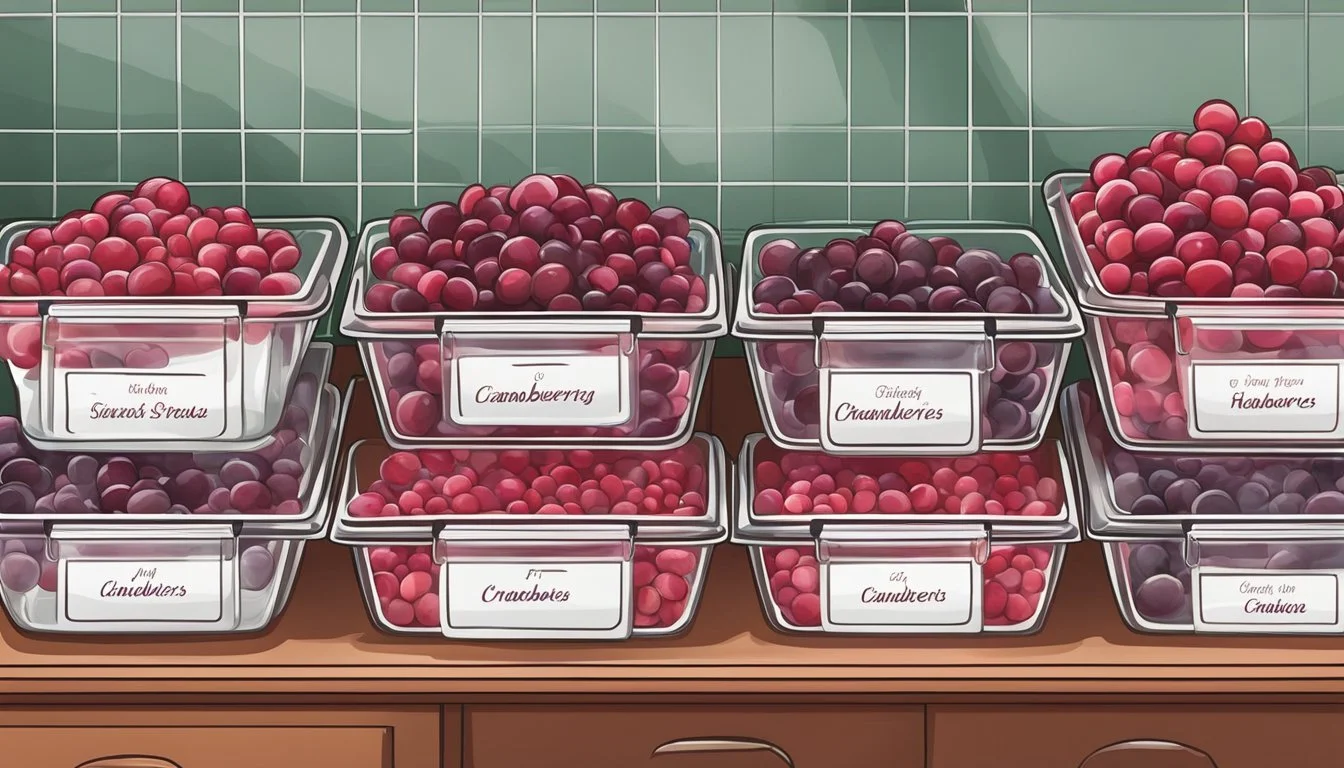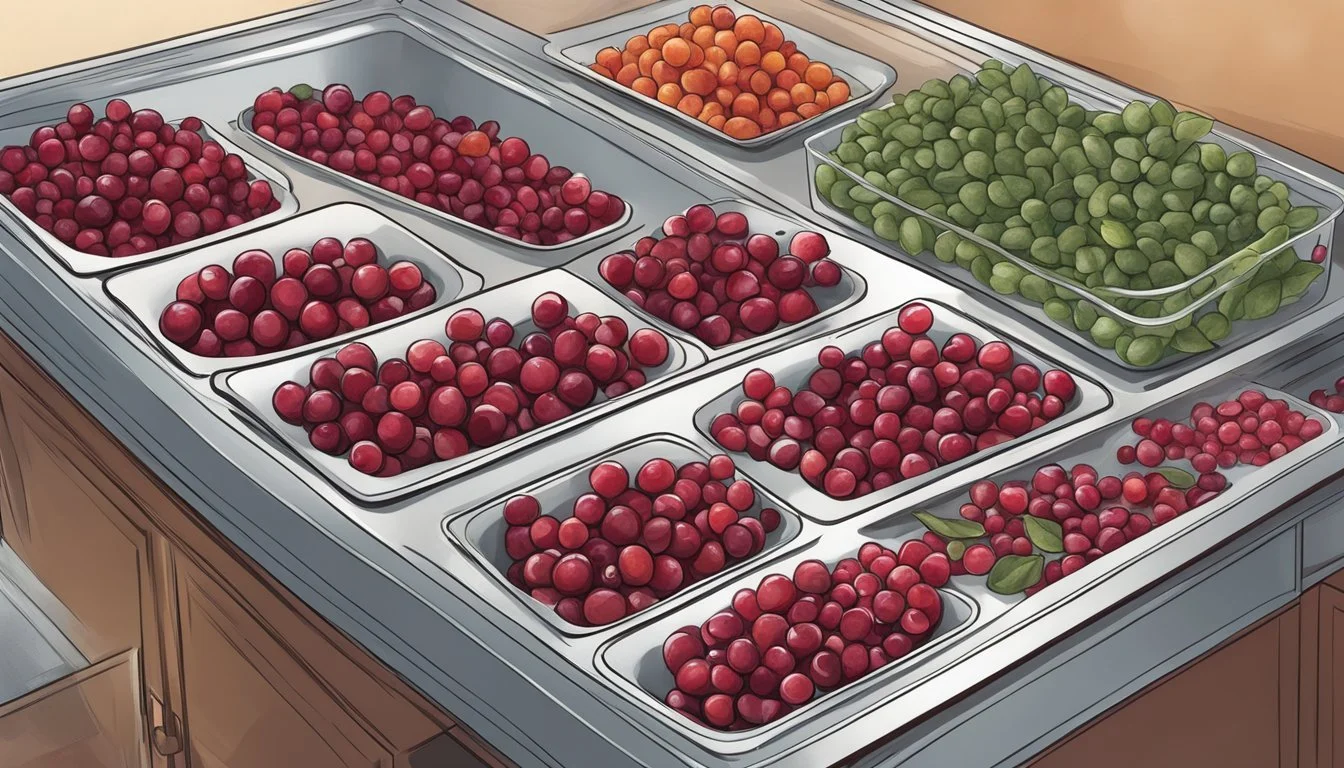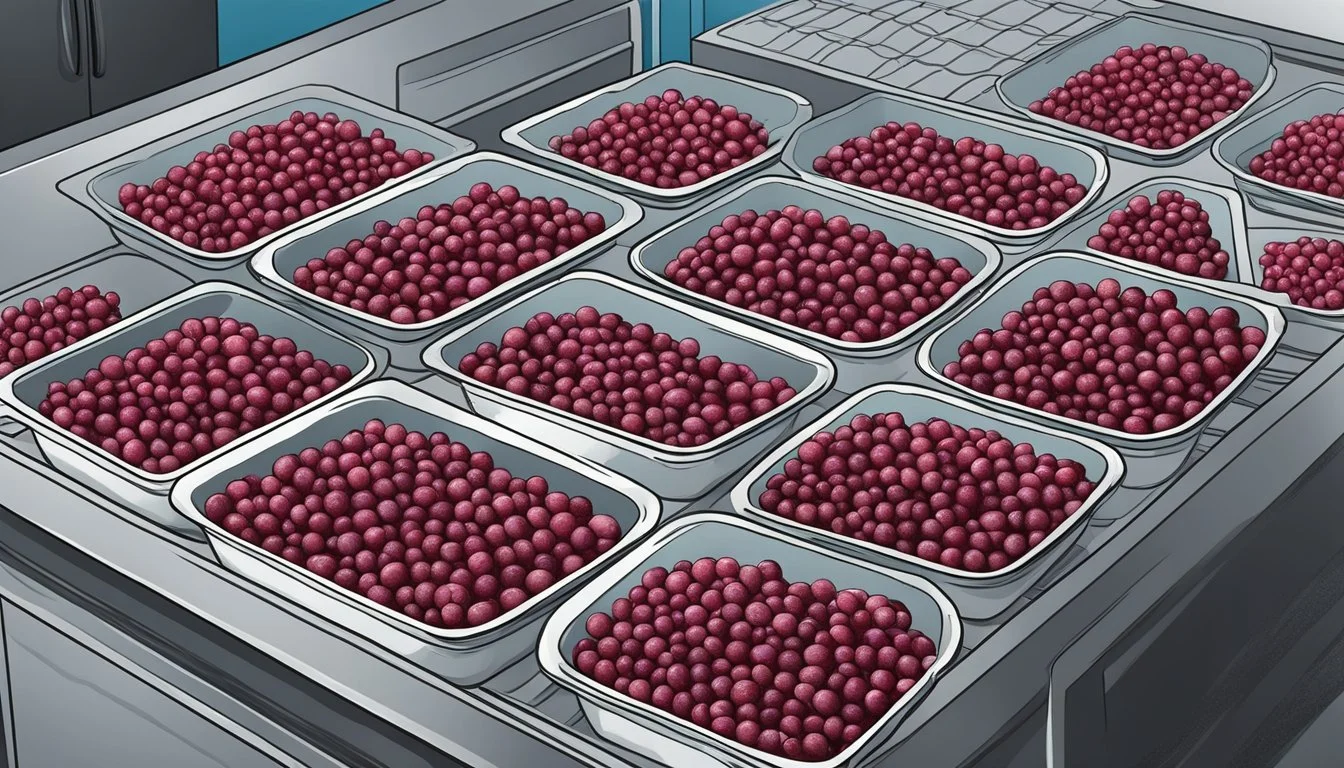How to Freeze Fresh Cranberries
Preserving Berries for Festive Treats
Cranberries, with their vibrant color and tangy flavor, are a staple in many holiday recipes. However, their season is quite short, typically from October to December in the Northern Hemisphere. To enjoy cranberries outside of their fresh season, one can freeze them effectively, ensuring they retain much of their texture and flavor for later use. This process starts with selecting the freshest cranberries, preferably firm to the touch and deep red in color, indicative of ripeness and peak flavor.
Freezing cranberries is a straightforward task that, when done correctly, can greatly extend the shelf life of this seasonal fruit. The cranberries must be thoroughly cleaned and sorted to remove any stems, leaves, or damaged berries. It also involves drying the berries completely to avoid ice crystal formation, which can degrade the texture. Once cleaned, they should be spread out in a single layer on a baking sheet to freeze individually. This prevents the berries from clumping together, making them easier to use later.
After the cranberries are frozen solid, typically within a few hours, they should be transferred to a freezer-safe container or bag. This helps to protect the fruit from freezer burn and oxidation. The frozen cranberries can last up to a year in the freezer, maintaining quality and taste—perfect for adding to sauces, baked goods, or as a vibrant garnish for holiday dishes.
Benefits of Freezing Cranberries
Freezing is an efficient method to preserve cranberries beyond their typical season. It allows consumers to maintain a stockpile of this nutrient-rich fruit for long-term utility without sacrificing quality or nutritional value.
Extended Shelf Life
Cranberries, when frozen correctly, can last in the freezer for up to one year. This substantially extends their shelf life beyond what one would expect from fresh cranberries, which typically last in the refrigerator for about 20 days. Freezing enables households to buy cranberries in bulk during peak season and save them for later use, which can also help save money by avoiding off-season prices.
Retained Nutrients
One important aspect of freezing cranberries is that it helps retain their nutritional value. Cranberries are loaded with vitamins, antioxidants, and other beneficial nutrients that remain largely unchanged during the freezing process. This means that even after months in the freezer, thawed cranberries will still contribute beneficial components to any dish, as nutritious as they would be when fresh.
Year-Round Availability
Due to their limited growing season, cranberries are typically harvested between September and November in the Northern Hemisphere. Freezing cranberries ensures that they can be enjoyed year-round, eliminating the constraints of seasonal availability. Consequently, one can incorporate cranberries into various recipes at any time, be it for a summer barbeque sauce or a festive holiday dish during winter.
Selecting Cranberries for Freezing
When preserving cranberries by freezing them, the selection process is critical to ensure the quality of your holiday recipes. One should consider the freshness of the berries as well as the type—organic versus conventional—prior to freezing.
Freshness Criteria
Fresh cranberries for freezing should be:
Firm: They should resist pressure when squeezed lightly, indicating ripeness and freshness.
Bright and uniform in color: Deep red is preferable, as it denotes maturity and optimal flavor.
Free of blemishes: Inspect for any soft spots, discolorations, or signs of spoilage.
Dry and clean: After washing them in a colander under running water, they need to be dried thoroughly to prevent ice crystals.
To test their readiness for freezing, gently bounce the cranberries on a hard surface. Fresh cranberries will have a slight bounce due to their firmness.
Organic Vs. Conventional
When choosing between organic and conventional cranberries:
Aspect Organic Cranberries Conventional Cranberries Pesticide Exposure Lower levels or no synthetic pesticides used in cultivation. May have been treated with synthetic pesticides. Environmental Impact Organic farming practices focus on sustainability and soil health. Conventional methods might not prioritize these aspects. Cost and Availability Usually more expensive and less available in all markets. More widely available and typically cheaper than organic options.
One must weigh these factors based on personal preference, budget, and the intended use in holiday recipes when selecting the type to freeze. Consumers should understand that the organic label ensures the berries were grown following specific regulations that limit synthetic inputs during cultivation.
Preparation Before Freezing
Proper preparation of fresh cranberries before freezing is essential to maintain their quality and flavor. This involves thorough washing, optional blanching, and careful sorting to ensure only the best berries are preserved.
Washing and Drying
Fresh cranberries should be washed in a colander to remove any impurities. After washing, they are to be spread out on a clean surface lined with parchment paper or a towel, allowing them to dry completely. Air drying is recommended for about 15 minutes to ensure no excess moisture is present, which could lead to freezer burn.
Blanching Process
Blanching is an optional step that can help preserve the cranberries' vibrant color and extend their shelf life. One blanches cranberries by immersing them in boiling water for a few seconds and then promptly placing them in ice water. After blanching, the berries should be drained thoroughly using a colander and dried as mentioned above.
Sorting and De-stemming
The cranberries must be inspected carefully before freezing. One should sort through the berries, removing any that are damaged or soft, as well as any lingering stems. One wants to freeze only the best quality, firm fresh cranberries to ensure a superior product when they are later thawed and used in holiday recipes.
Freezing Techniques
Freezing cranberries correctly preserves their freshness and flavor, making them perfect for holiday recipes. The key is to prevent freezer burn and clumping, ensuring individual berries remain intact for later use.
Flash Freezing Method
Flash freezing is an ideal way to freeze cranberries that keeps each berry separate and easy to measure out for recipes. The process involves:
Preparing the Berries: They should first be rinsed and any damaged or soft berries removed. It is important to dry them thoroughly with a paper or clean kitchen towel.
Spreading Berries: Lay the berries out in a single layer on a baking sheet that won't cause the berries to stick. If necessary, lining the baking sheet with parchment paper helps.
Freezing: Place the baking sheet in the freezer and flash freeze the berries until solid (approximately 1-2 hours).
Transferring: Once frozen, quickly move the berries to an airtight container or freezer bags to prevent freezer burn.
Portion Packing
Packing cranberries in portions simplifies future use, as they can be conveniently taken out and directly used in recipes.
Measurement: Decide on portion sizes according to typical recipe requirements or personal preference.
Packing: Place these portions into freezer bags or an airtight container like a mason jar. If using freezer bags, remove as much air as possible to protect flavor and texture.
Sealing: For optimal preservation, a vacuum sealer can be used to remove air and seal the cranberries in the freezer bags, prolonging their freshness.
Labeling: Clearly label each pack with the date to track how long the cranberries have been stored.
Utilizing flash freezing followed by vacuum sealing in bags or placing in airtight containers will keep cranberries fresh for use in holiday recipes throughout the year.
Proper Storage and Organization
When freezing fresh cranberries, it's vital to prioritize proper storage techniques and organization to maintain their quality. Using the right materials and strategies can prevent freezer burn and optimize freezer space.
Labeling and Dating
One should label freezer bags or airtight containers with the date of freezing and the contents within. Clear labeling prevents mix-ups and helps track how long cranberries have been stored. It's a simple but crucial step in freezer storage management.
Use a permanent marker to label each bag or container.
Include: The word "Cranberries," the quantity, and the freezing date.
Avoiding Freezer Burn
Freezer burn can diminish the flavor and texture of cranberries, making them less appealing for holiday recipes. To avoid this:
Dry cranberries thoroughly before freezing to minimize ice crystal formation.
Pack them in airtight containers or freezer bags to protect against air exposure.
Packaging Type Tips for Avoidance of Freezer Burn Freezer Bags Remove as much air as possible before sealing. Airtight Containers If using a mason jar, leave some headspace for expansion.
Freezer Space Management
Effective freezer space management involves organizing cranberries in a way that maximizes available storage. Storing too many items in the freezer can lead to uneven cooling and increased risk of freezer burn.
Arrange cranberries in a single layer on a baking sheet to freeze initially.
Once frozen, transfer to their labeled storage containers.
Consideration Action to Take Accessibility Place cranberries in an easily accessible area of the freezer. Efficiency Store flat to stack multiple bags or containers neatly.
Using Frozen Cranberries
Frozen cranberries are a versatile ingredient that can be used in a variety of dishes, from baked goods to smoothies. They can either be thawed or used straight from the freezer, depending on the recipe.
Thawing Guidelines
To thaw frozen cranberries, one should place them in the refrigerator overnight. For a quicker method, they can be placed in a colander under cold running water until thawed. It's important to thoroughly drain the cranberries and pat them dry to remove excess moisture.
Refrigerator Thawing: Overnight
Cold Water Thawing: A few minutes; monitor to avoid sogginess.
Cooking and Baking Uses
Frozen cranberries need not be thawed when used in baking. They can be added directly from the freezer to the batter for muffins or other baked goods. This helps maintain the shape of the cranberries and prevents bleeding. When baking with frozen cranberries, one might need to extend the baking time slightly.
Direct Use: Add frozen cranberries to batter for muffins, bread, or cakes.
Baking Sheet: Use when roasting cranberries as a standalone dish or for incorporating into other recipes.
Raw Application Ideas
Frozen cranberries can be incorporated into cold dishes or used to make smoothies and salad dressings. They add a tart flavor and a pleasant pop of color.
Smoothies: Add directly to the blender.
Salad Dressings: Blend thawed cranberries to incorporate into dressings.
Yogurt: Stir into yogurt for a cold treat.
Remember to adjust additional sweeteners in the recipe, as cranberries have a naturally bright and tangy flavor that can be more pronounced when frozen and then incorporated into dishes.
Alternative Cranberry Forms
When preserving the vibrant taste of cranberries for holiday recipes, consider freezing not just the fresh berries but also other cranberry forms, such as cranberry sauce and dried cranberries. Proper preparation enhances longevity and maintains the quality of these products for festive occasions.
Cranberry Sauce Preservation
Freezing Cranberry Sauce: Homemade or leftover cranberry sauce can be effectively frozen. First, ensure that the sauce is cooled completely at room temperature. Then, it can be portioned into ice cube trays for convenient usage in future recipes. Once the sauce is solidified in the trays, the cubes should be transferred to a freezer-safe bag or container, labeled with the date, and stored in the freezer. It is suggested to use frozen cranberry sauce within six months for the best quality.
Dried Cranberry Preparation
Storing Dried Cranberries: Dried cranberries add a concentrated burst of flavor to various dishes and can be stored in the freezer to extend their shelf life. Here are key steps for freezing dried cranberries:
Ensure dryness: Confirm that the cranberries are completely dry with no residual moisture to prevent ice crystals from forming.
Airtight packaging: Place the dried cranberries in a freezer-safe airtight container or a resealable freezer bag. Removing as much air as possible reduces the risk of freezer burn.
Labeling: Clearly label the container or bag with the date of freezing. Dried cranberries can be kept in the freezer for up to 12 months without a significant loss in quality.
These methods preserve the cranberries' integrity and ensure they are ready for use whenever required.
Creative Recipe Suggestions
Using frozen cranberries is an excellent way to infuse a pop of tartness and vibrant color into a variety of dishes throughout the year.
Desserts and Sweets
Frozen cranberries can transform sweet treats into festive delights. They are especially good in baked goods where their firm texture holds up well during the cooking process.
Smoothies: Add a tangy twist to morning smoothies with a handful of frozen cranberries. They offer a refreshing zing and a nutrient boost.
Baked Goods: Incorporate frozen cranberries into muffins, cakes, or bread for a burst of tart flavor. Their rigid structure withstands the baking process, offering pockets of juiciness.
Oatmeal: Stir frozen cranberries into oatmeal as it cooks, or sprinkle them on top right before serving for a hearty and nutritious breakfast option.
Cranberry Sauce: Make homemade cranberry sauce by simmering frozen cranberries with sugar and water until they burst and become saucy, perfect for holiday tables.
Savory Combinations
Cranberries are not just for the sweet tooth; they also lend an unexpected twist to savory dishes.
Sauces: Blend frozen cranberries into sauces for a unique sweet and sour flavor that complements roasted meats (What wine goes well with roasted meats?).
Stuffing: Elevate your stuffing by adding frozen cranberries for a touch of tartness that cuts through the richness of the dish.
Cranberry Recipes: Look beyond traditional uses and experiment with cranberries as a topping for grilled meats or mixed into relishes that add a vivid flavor contrast in savory dishes.
Frequently Asked Questions
Q: How long do frozen cranberries last?
A: Frozen cranberries can be stored in the freezer for up to one year without significant loss of quality.
Q: Can you freeze cranberries without washing them?
A: It's recommended to wash cranberries before freezing to remove any impurities. Make sure they are completely dry to prevent ice crystals from forming.
Q: Should cranberries be frozen in a single layer?
A: Yes, spreading cranberries in a single layer on a baking sheet to freeze ensures that they freeze evenly and do not clump together.
Q: Can I freeze other berries like raspberries and blueberries the same way as cranberries?
A: Raspberries and blueberries can also be frozen using a similar method. Just ensure they are dry and freeze in a single layer before transferring to a container.
Q: How do you defrost frozen cranberries?
A: Frozen cranberries can be thawed in the refrigerator or by rinsing them under cold water. They can also be used directly from the freezer in recipes.
Q: Is it necessary to remove any soft or damaged cranberries before freezing?
A: Yes, removing soft or damaged berries is crucial as they can spoil and affect the quality of the rest. Only freeze firm, ripe cranberries.
Q: Can you refreeze cranberries after thawing?
A: It's best to avoid refreezing cranberries as the thawing and refreezing process can degrade their texture and flavor.
Tips and Tricks for Best Results
When freezing cranberries, achieving the best results requires attention to detail and proper technique. Here are some essential tips and tricks:
Wash and Dry: Begin by thoroughly washing the cranberries to remove any dirt. It's vital to dry them completely to prevent ice crystals from forming.
Spread Out: Spread the cranberries in a single layer on a baking sheet. This prevents them from freezing into a single clump, making it easier to use smaller portions later.
Freeze in Stages: Initially, freeze the cranberries for 2-4 hours on the tray. Once frozen, transfer them to a freezer-safe bag.
Remove Air: Extracting as much air as possible from the freezer bags minimizes the risk of freezer burn and extends the berries' longevity.
Labeling: Always label your bags with the date. Cranberries can last in the freezer for up to one year, maintaining their quality and flavor.
For those looking to use their cranberries as a garnish or snack, one can freeze them in pre-measured amounts, ready to sprinkle over dishes or eat directly from the freezer. When freezing cranberries for use later as a snack, ensure they are easily accessible and in consumable portion sizes.
Store Bagged Cranberries Correctly: Position them in the coldest part of the freezer to prevent temperature fluctuations that can affect their quality.
By following these steps, one can confidently preserve the freshness and taste of cranberries, using them at their optimum state for holiday recipes and more.





